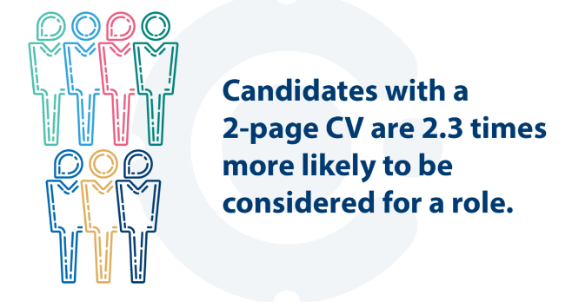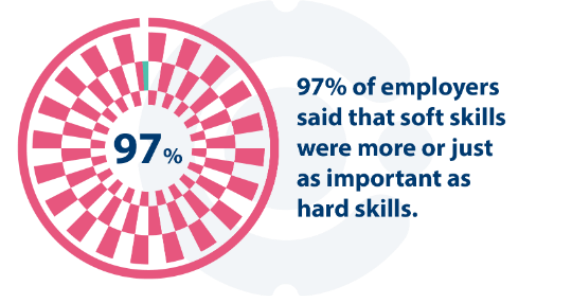A top-notch CV immediately serves two purposes:
The keywords match those the applicant tracking system (ATS) is looking for.
It gets the recruiting consultant’s attention.
An ATS will filter CVs by keywords, experience, education etc. Tailoring your CV to match the specs in the job listing is key to getting approved by an ATS. Authorised CVs are passed along to a recruiter, who on average spends 6-7 seconds scanning a CV to decide if the applicant is suitable. To catch a recruiter’s eye, it’s advised to ensure they can easily find the most relevant information, as quickly as possible. 63% of recruiters want to receive CVs tailored to meet the advertised job specs. In a job ad, the job description will give a clear understanding of the role. But a more detailed job specification will allow applicants to know if they are qualified for the position. A CV should include skillsets, previous experience, and metrics relevant to the role and the job specs. Candidates working directly with a recruiter can get advice on tailoring a CV to a specific role and on what specs are most important to the hiring manager.
CV Structure

Word count matters. It’s crucial for a CV to be succinct and easily digestible. A 2-page CV is 2.3 times more likely to be chosen to be considered for a role.
Start with the personal bio, list important work milestones with related KPI’s. Follow this with a brief listing of relative work experience and finish with skillset and education.
Jobseekers should be constantly adapting their CV and personal statement to match the job they are applying for, highlighting their experience and skills that are most relevant to the advertised role.
Personal Bio
The first page of the CV needs to engage the reader instantly. A good recommendation is to include a strong CV bio. Essentially, this is an introduction to a CV, a sales pitch, putting the applicant forward as a professional, highlighting their suitability for the role and company culture. A good CV bio is clear, immediately captures the reader’s attention, and contains soft skills.
Soft skills

Soft skills are interpersonal skills such as the ability to communicate well with other people and to work in a team. Experience, education, and learned sector-specific hard skills are essential to guarantee a CV to be spotted by hiring managers. But an individual's natural characteristics also play a significant part in the recruitment process.
Employers are interested not just in job roles, but also in candidates’ personal abilities. A candidate who has good communication and teamwork skills is more likely to thrive in a variety of work environments. In a survey by SHRM, 97% of employers said that soft skills were more or just as important as hard skills.
Milestones and KPI’s
Data and results are an applicant’s best friend. The milestone and KPI section in a CV is a chance to highlight facts and figures that represent achievements throughout their job history. To impress, a direct and data driven approach is key. Keep it relevant and straight to the point. A jobseeker should have a few alternative achievements to list on their CV to suit specific roles they’re applying for.
For those looking for a job in the Technology and IT sector, it is important to include the technology stack used to achieve the KPI included as it demonstrates tech skills in action.
Example of formatting:
Led a team of 10 engineers in the building and execution of an error analysis system – managed deliverables & met strict deadlines. New system decreased the mobile department's development production time by 35%.
Technology used: Django, Java, Python.
For a non-tech specific CV, achievements should be formatted similarly, keeping it concise, including data and results.
Example:
Project managed website build with external agency. Delivered on time and scope. New site led to a 40% increase in traffic and drove 20% of in revenue in 2020.
Work History
An applicant’s work history gives the hiring manager a snapshot of their experience. A recruiter wants to be able to scan a CV and get a gist of the applicant’s past employers, positions, and relevant tasks. This is an easy way for them to see if an applicant ticks the position's must-have boxes.
It’s important to reiterate that there is no need for an applicant to list every job they’ve had on their CV. It’s better to include the roles that align the applicant with the job. For example, it wouldn’t be advantageous for someone applying for a Software Developer role to include a previous retail or hospitality experience. An applicant needs to include work history that puts them forward as a promising candidate for the job.
Many people have experienced gaps in their CV, for a myriad of different reasons. Jobseekers shouldn’t try to fill in gaps by extending start or end dates. Don’t be afraid to have employment gaps, it’s normal and honesty is the best policy when it comes to communicating with a prospective employer. An understanding hiring manager will view the gap of employment as a talking point in the interview stages.
Work history on a CV should be easily read, listed chronologically, including job title and top tasks for each role. It’s advised to stay away from long paragraphs regarding daily tasks, 1-2 lines is substantial. Stick to tasks that are relevant to the job specs.
Presentation tips
Use a regular font – Calibri (Body), Arial, and Times New Roman
Use bullet points instead of paragraphs
Use numerals instead of written numbers
Use headings and bold text to make important information stand out
Keep font size between 10.5 and 12
List information in chronological order
Save CV as a Word doc
Skillset and education
If an applicant’s skillset isn’t updated on their CV, they are less likely to be put forward for an interview. Continuous learning is essential for most sectors but even more for the ever-evolving tech industry. In fact, a report conducted by Dell Technologies predicted that over 85% of the jobs that will exist in 2030 haven’t been created yet. Many of these predicted changes are down to advancements in technology such as AI and IoT. Technology itself progresses at lightning speed, with new processes being developed constantly. It’s now a more important time than ever for qualified candidates to be constantly expanding and refining their skillset. Applicants who constantly update their education and skillsets show their commitment to continuous learning and a passion for the industry they work in.
LinkedIn is the perfect place for professionals to highlight what they can’t in their CV. On LinkedIn, a person can speak in greater depth about their career and showcase all roles and responsibilities they’ve had throughout their employment history.
LinkedIn is also a huge part of a recruiter's day-to-day job, with 87% of recruiters using LinkedIn during the recruitment process. Recruiters can easily search for people who have worked at a particular company or have attained a specific qualification. Someone who details their entire work history on their profile has a much greater chance of being found and recruited. Tagging previous workplaces and connecting with former colleagues adds credibility and weight to a LinkedIn profile. Another great thing about LinkedIn is that it hosts a professional's entire job history in one place, making CV creation and updating less daunting when job hunting.
Conclusion
Our takeaway advice is if an applicant wants to stand out from the crowd, tailoring their CV to the position to which you are applying for is vital. A clean and well-structured CV makes sure that recruiters and hiring managers can find the information they need quickly and efficiently. Staying aware of the candidate's market and opportunities could just land you your dream job.
Our recruiters at Cpl are career experts. Whether it's advice on CV writing or interview techniques, our consultants will guide you every step of the way. Get in touch.
Sources:
41% of Workers Will Look for a New Job in the First Half of 2022, ValuePenguin, Dec 2021.
Career Guide, Indeed.com, June 2021.
Resume Statistics 2021, Zety.com.
Settling the Debate, ResumeGo.
Leaders and Employees Need Soft Skills Now More than Ever, SHRM, May 2020.
Realizing 2030 A Divided Vision of the Future, Dell Technologies.
81 LinkedIn Statistics You Need to Know in 2022, Omnicore agency.
